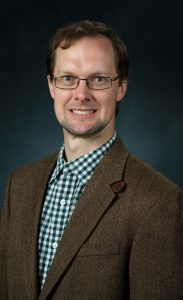OXFORD, Miss. – Carbon is the go-to element when studying molecules in space. It is necessary for life, easy to study and forms unusually strong bonds with other atoms.
With more than 90 other naturally occurring elements in the periodic table, however, a University of Mississippi chemist is asking why scientists are limiting their scope of research.
“The periodic table does have other elements,” said Ryan Fortenberry, associate professor of chemistry and biochemistry. “Although the chemistry isn’t as rich, and they are more difficult to study. A lot of the other materials can be dangerous, poisonous or lethal.”

Chemistry professor Ryan Fortenberry is gaining new insights into how inorganic molecules help dust and small particles in space come together to eventually form planets. Photo by Thomas Graning/Ole Miss Digital Imaging Services
Some inorganic molecules could have implications in the formation of planets, so Fortenberry and his research team have used computer models in a study to illustrate this. He presented their findings at the American Chemical Society‘s fall meeting Aug. 23 in Chicago.
“If you want to make big rocks, you have to start with small rocks, which had to start from even smaller rocks – this is the nanoscale,” Fortenberry said. “We have a pretty good idea of how we can get from these dust particles to bigger rocks and then to big rocks like the Earth.”
Think of molecules like Lego pieces, he said. Carbon, for example, has the capability for four other pieces to stick to it. In Fortenberry’s study, the team “stuck” three hydrogen molecules on an aluminum molecule and simulated its reaction with water.
The result? Interactions between aluminum hydride and water can form a variety of molecules. Some of these could be important precursors to common minerals in the Earth and other rocky planets.
“This is the first time, to my knowledge, that anyone has taken simple hydrides and created complex large nanocrystals,” Fortenberry said.
There are a number of ways to build upon these findings.
“What we constructed is a very clean and pretty ideal set of circumstances, but nature is messy,” Fortenberry said. “So, we want to explore the messiness with imperfect starting materials and see if they still lead to crystalline products.
“We’ve also done this with a convenient system: aluminum. We’d have to be more creative with something like silicon. We can mix together other molecules that we know exist in space and see how they progress.”
This work opens the door to possibilities for future collaborations, said Heather Abbott-Lyon, past chair of the ACS astrochemistry subdivision and associate professor of chemistry at Kennesaw State University.
“Dr. Fortenberry’s quantum chemical calculations support observational astronomy by providing key information about compounds that might be plentiful in space, but that are extremely difficult to produce in the lab,” Abbott-Lyon said.
“His ability to engage his audience and effectively communicate his science at ACS meetings is crucial to advancing the conversation between chemists and astronomers.”
Fortenberry first discovered his passion for astrochemistry about 12 years ago at an ACS meeting.
“It was the first time I had gone to a meeting where astrochemistry was being discussed,” he said. “I didn’t know anybody and didn’t know what I was talking about – I asked naïve questions. But I thought sitting there, ‘These are my people.'”
This realization led to Fortenberry’s postdoctoral fellowship at the NASA Ames Research Center in Mountain View, California. His adviser was a quantum chemist who was doing astrochemistry work. The rest was history.
Fortenberry’s past studies have used supercomputers to simulate how light interacts with molecules in space. He has published more than 100 articles in scientific journals and is an advocate for effective science communication.
He plans to continue his work at Ole Miss with the recently funded award no. 80NSSC22M0220 – NASA EPSCoR R3 APPENDIX A: The Energy Cost of Producing Water and Chemical Feedstocks from Lunar Regolith.
Fortenberry recently led a Mississippi EPSCoR workshop for researchers that featured tips for speaking with journalists and those with nonscience backgrounds. The workshop was supported by National Science Foundation grant OIA-1757220, MS EPSCoR Center for Emergent Molecular Optoelectronics.